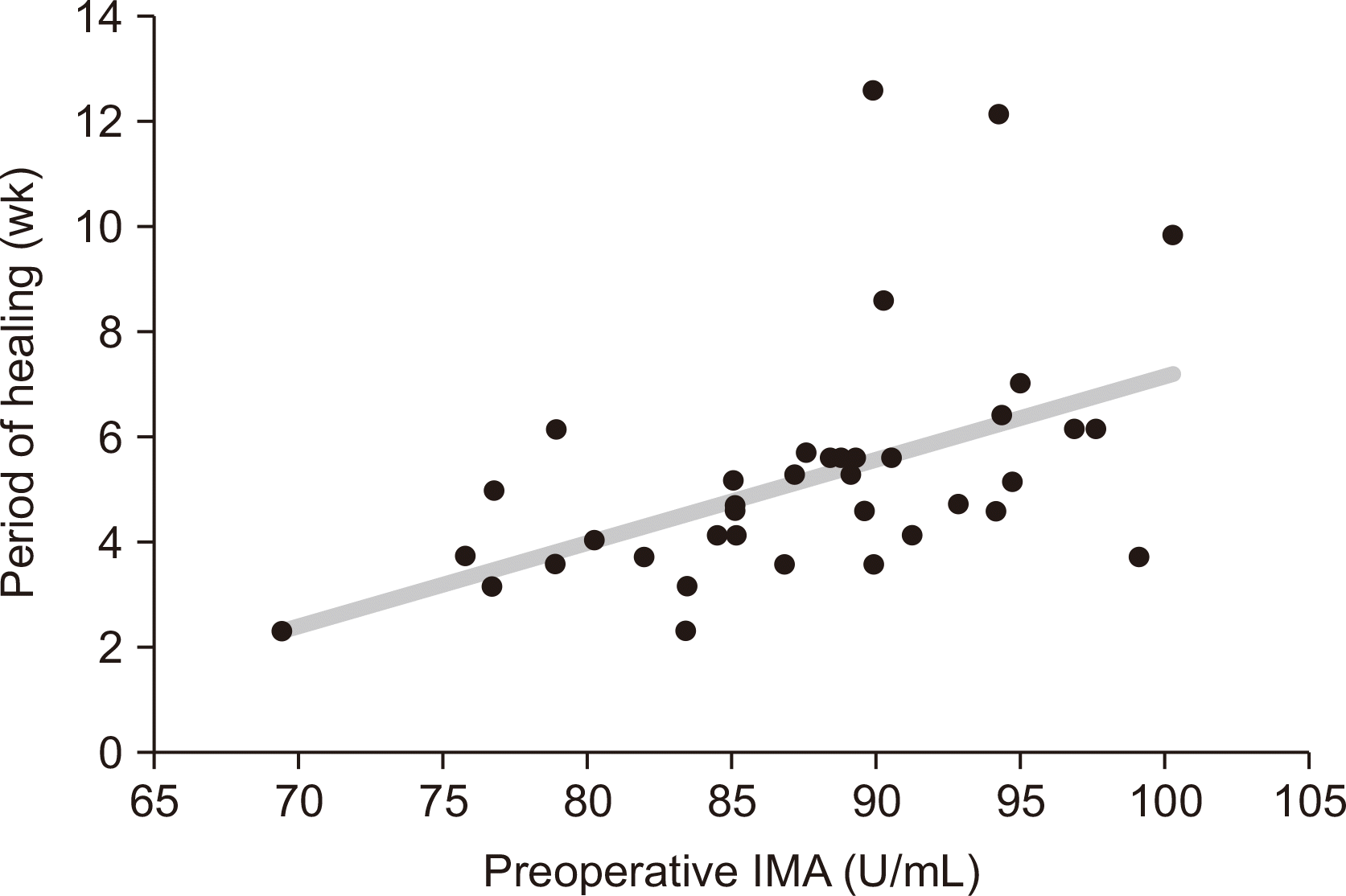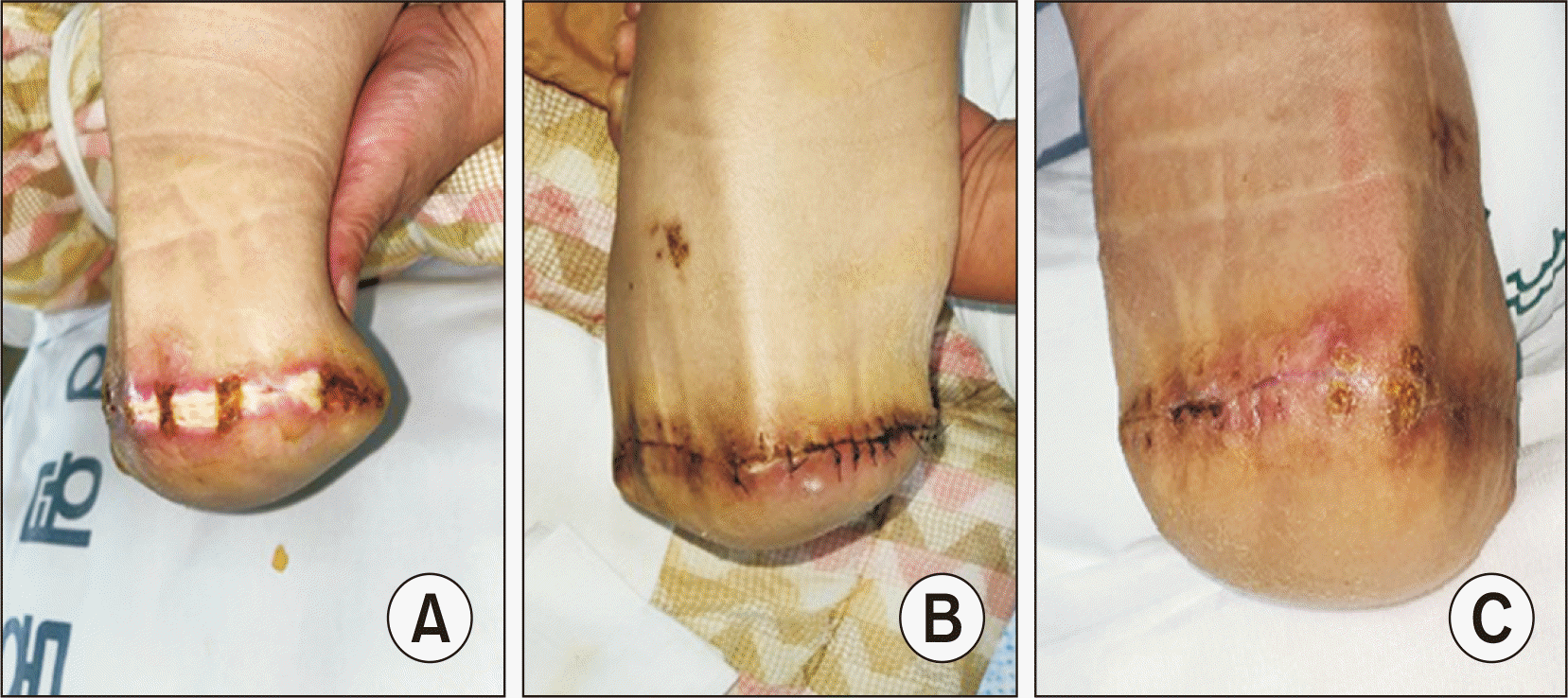1. Boulton AJ. 2013; The pathway to foot ulceration in diabetes. Med Clin North Am. 97:775–90. doi: 10.1016/j.mcna.2013.03.007. DOI:
10.1016/j.mcna.2013.03.007. PMID:
23992891.

2. Gregg EW, Sorlie P, Paulose-Ram R, Gu Q, Eberhardt MS, Wolz M, et al. 2004; Prevalence of lower-extremity disease in the US adult population ≥40 years of age with and without diabetes: 1999-2000 national health and nutrition examination survey. Diabetes Care. 27:1591–7. doi: 10.2337/diacare.27.7.1591. DOI:
10.2337/diacare.27.7.1591. PMID:
15220233.
3. Kram HB, Appel PL, Shoemaker WC. 1989; Prediction of below-knee amputation wound healing using noninvasive laser Doppler velocimetry. Am J Surg. 158:29–31. doi: 10.1016/0002-9610(89)90310-3. DOI:
10.1016/0002-9610(89)90310-3. PMID:
2662788.

4. Ratliff DA, Clyne CA, Chant AD, Webster JH. 1984; Prediction of amputation wound healing: the role of transcutaneous pO2 assessment. Br J Surg. 71:219–22. doi: 10.1002/bjs.1800710320. DOI:
10.1002/bjs.1800710320. PMID:
6697129.

5. Reiber GE, Pecoraro RE, Koepsell TD. 1992; Risk factors for amputation in patients with diabetes mellitus. A case-control study. Ann Intern Med. 117:97–105. doi: 10.7326/0003-4819-117-2-97. DOI:
10.7326/0003-4819-117-2-97. PMID:
1605439.

6. Zhou ZY, Liu YK, Chen HL, Yang HL, Liu F. 2015; HbA1c and lower extremity amputation risk in patients with diabetes: a meta-analysis. Int J Low Extrem Wounds. 14:168–77. doi: 10.1177/1534734615593190. DOI:
10.1177/1534734615593190. PMID:
26130760.
7. Zhao W, Katzmarzyk PT, Horswell R, Wang Y, Johnson J, Heymsfield SB, et al. 2013; HbA1c and lower-extremity amputation risk in low-income patients with diabetes. Diabetes Care. 36:3591–8. doi: 10.2337/dc13-0437. DOI:
10.2337/dc13-0437. PMID:
24062322. PMCID:
PMC3816880.

8. Matsushita K, Ballew SH, Coresh J, Arima H, Ärnlöv J, Cirillo M, et al. 2017; Measures of chronic kidney disease and risk of incident peripheral artery disease: a collaborative meta-analysis of individual participant data. Lancet Diabetes Endocrinol. 5:718–28. doi: 10.1016/S2213-8587(17)30183-3. DOI:
10.1016/S2213-8587(17)30183-3. PMID:
28716631.
9. Kurniawati A, Ismiarto YD, Hsu IL. 2019; Prognostic factors for lower extremity amputation in diabetic foot ulcer patients. J Acute Med. 9:59–63. doi: 10.6705/j.jacme.201906_9(2).0003.
10. Shevtsova A, Gordiienko I, Tkachenko V, Ushakova G. 2021; Ischemia-modified albumin: origins and clinical implications. Dis Markers. 2021:9945424. doi: 10.1155/2021/9945424. DOI:
10.1155/2021/9945424. PMID:
34336009. PMCID:
PMC8315882.

11. Sinha MK, Gaze DC, Tippins JR, Collinson PO, Kaski JC. 2003; Ischemia modified albumin is a sensitive marker of myocardial ischemia after percutaneous coronary intervention. Circulation. 107:2403–5. doi: 10.1161/01.CIR.0000072764.18315.6B. DOI:
10.1161/01.CIR.0000072764.18315.6B. PMID:
12742986.

12. Calhoun JH, Cantrell J, Cobos J, Lacy J, Valdez RR, Hokanson J, et al. 1988; Treatment of diabetic foot infections: Wagner classification, therapy, and outcome. Foot Ankle. 9:101–6. doi: 10.1177/107110078800900301. DOI:
10.1177/107110078800900301. PMID:
3229695.

13. Sbarouni E, Georgiadou P, Kremastinos DT, Voudris V. 2008; Ischemia modified albumin: is this marker of ischemia ready for prime time use? Hellenic J Cardiol. 49:260–6.
14. Apple FS, Wu AH, Mair J, Ravkilde J, Panteghini M, Tate J, et al. 2005; Future biomarkers for detection of ischemia and risk stratification in acute coronary syndrome. Clin Chem. 51:810–24. doi: 10.1373/clinchem.2004.046292. DOI:
10.1373/clinchem.2004.046292. PMID:
15774573.

15. Bourdon E, Loreau N, Blache D. 1999; Glucose and free radicals impair the antioxidant properties of serum albumin. FASEB J. 13:233–44. doi: 10.1096/fasebj.13.2.233. DOI:
10.1096/fasebj.13.2.233. PMID:
9973311.

16. Chan B, Dodsworth N, Woodrow J, Tucker A, Harris R. 1995; Site-specific N-terminal auto-degradation of human serum albumin. Eur J Biochem. 227:524–8. doi: 10.1111/j.1432-1033.1995.tb20419.x. DOI:
10.1111/j.1432-1033.1995.tb20419.x. PMID:
7851432.

17. Ma SG, Wei CL, Hong B, Yu WN. 2011; Ischemia-modified albumin in type 2 diabetic patients with and without peripheral arterial disease. Clinics (Sao Paulo). 66:1677–80. doi: 10.1590/s1807-59322011001000003.
18. Wukich DK, Ahn J, Raspovic KM, Gottschalk FA, La Fontaine J, Lavery LA. 2017; Comparison of transtibial amputations in diabetic patients with and without end-stage renal disease. Foot Ankle Int. 38:388–96. doi: 10.1177/1071100716688073. DOI:
10.1177/1071100716688073. PMID:
28103735.

19. Pollard J, Hamilton GA, Rush SM, Ford LA. 2006; Mortality and morbidity after transmetatarsal amputation: retrospective review of 101 cases. J Foot Ankle Surg. 45:91–7. doi: 10.1053/j.jfas.2005.12.011. DOI:
10.1053/j.jfas.2005.12.011. PMID:
16513503.

20. Chen J, Xie D, Shlipak MG, Townsend RR, Appel LJ, et al. Mohler ER 3rd. 2012; Risk factors for peripheral arterial disease among patients with chronic kidney disease. Am J Cardiol. 110:136–41. doi: 10.1016/j.amjcard.2012.02.061. DOI:
10.1016/j.amjcard.2012.02.061. PMID:
22465315. PMCID:
PMC3586781.

21. Dounousi E, Papavasiliou E, Makedou A, Ioannou K, Katopodis KP, Tselepis A, et al. 2006; Oxidative stress is progressively enhanced with advancing stages of CKD. Am J Kidney Dis. 48:752–60. doi: 10.1053/j.ajkd.2006.08.015. DOI:
10.1053/j.ajkd.2006.08.015. PMID:
17059994.

22. Ruthenborg RJ, Ban JJ, Wazir A, Takeda N, Kim JW. 2014; Regulation of wound healing and fibrosis by hypoxia and hypoxia-inducible factor-1. Mol Cells. 37:637–43. doi: 10.14348/molcells.2014.0150. DOI:
10.14348/molcells.2014.0150. PMID:
24957212. PMCID:
PMC4179131.

23. Refaai MA, Wright RW, Parvin CA, Gronowski AM, Scott MG, Eby CS. 2006; Ischemia-modified albumin increases after skeletal muscle ischemia during arthroscopic knee surgery. Clin Chim Acta. 366:264–8. doi: 10.1016/j.cca.2005.10.020. DOI:
10.1016/j.cca.2005.10.020. PMID:
16337614.

24. Zapico-Muñiz E, Santaló-Bel M, Mercé-Muntañola J, Montiel JA, Martínez-Rubio A, Ordóñez-Llanos J. 2004; Ischemia-modified albumin during skeletal muscle ischemia. Clin Chem. 50:1063–5. doi: 10.1373/clinchem.2003.027789. DOI:
10.1373/clinchem.2003.027789. PMID:
15161723.

25. Lee DH, Jeon HK, Park HJ, Shin WS, Lee SW, Youn HJ, et al. 2010; Change in ischemia-modified albumin and its clinical significance during exercise stress testing. Circ J. 74:484–9. doi: 10.1253/circj.cj-09-0581. DOI:
10.1253/circj.CJ-09-0581. PMID:
20057159.






 PDF
PDF Citation
Citation Print
Print




 XML Download
XML Download